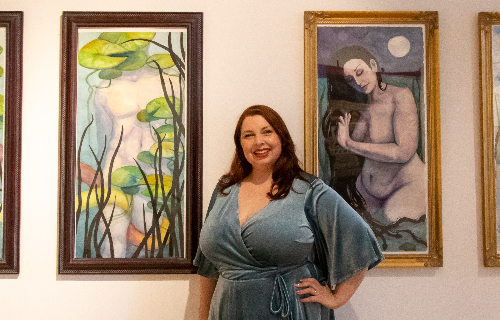Being half Latinx and half white, Nicole Rudolph-Vallerga always felt like she didn’t quite fit into either group.
“Being categorized as ‘in-between’ is a lonely place to be, as those who fall between definitions tend to not be fully accepted by either side, therefore lacking in community,” she explained on her website.
So, she decided to create her own community with her fall senior art show, “Séance of Duality,” at UC Santa Cruz. The show featured photographs and interviews with biracial Latinx people, and incorporated the visual language of Victorian seances and Mexican ofrendas. The goal was to focus on the whole person, not a person divided.
She was touched by how affected viewers were by her work.
“Some people who came cried,” she said. “They said, ‘I have never felt seen before, and I feel seen now.’”
Rudolph-Vallerga continued exploring the theme this spring with her series “Liminal Spaces.” The show addresses moments of transition, such as when someone falls in love or is recovering from a trauma.
“It’s these times when we’re trying to rush through it because it’s a time of uncertainty and it's hard on us,” she said. “I invite the viewer to sit with these moments.”
The watercolor series includes the diptych painting Water Lovers, featuring a nude couple connected through time and space, and Cocoon, which features Rudolph-Vallerga’s own premature baby protected by succulents.
The series is displayed alongside another series, “Artifacts of Location,” which includes a book, audio recordings, and a quilt that locate where she was in 2020 at the beginning of the COVID-19 pandemic.
Born in Hollywood to a white father and Mexican-American mother, Rudolph-Vallerga grew up poor on a small ranch in the Los Padres National Forest. She worked as a preschool teacher, and then an elementary school art teacher before going to Cabrillo College. She and her husband then transferred to UC Santa Cruz, where they are both pursuing their studies.
Now 39 and the mother of a 3-year-old son, she said it took her a while to figure out how to navigate the bureaucracy of higher education because, as a first-generation college student, she had no guidance on how to proceed.
She is so grateful to be at UC Santa Cruz that she has taken advantage of every opportunity given to her—a fact that hasn’t gone unnoticed. She has been named the winner of the Chancellor’s Award for Arts.
Next up, she plans to pursue a doctoral degree and, ultimately, become a museum curator. Her goal is to make museums more inclusive.
“I want to change the art world,” she said.
Nicole Rudolph-Vallerga
Porter; art and history of art and visual culture (HAVC), curation heritage, and museums concentration (double major)



